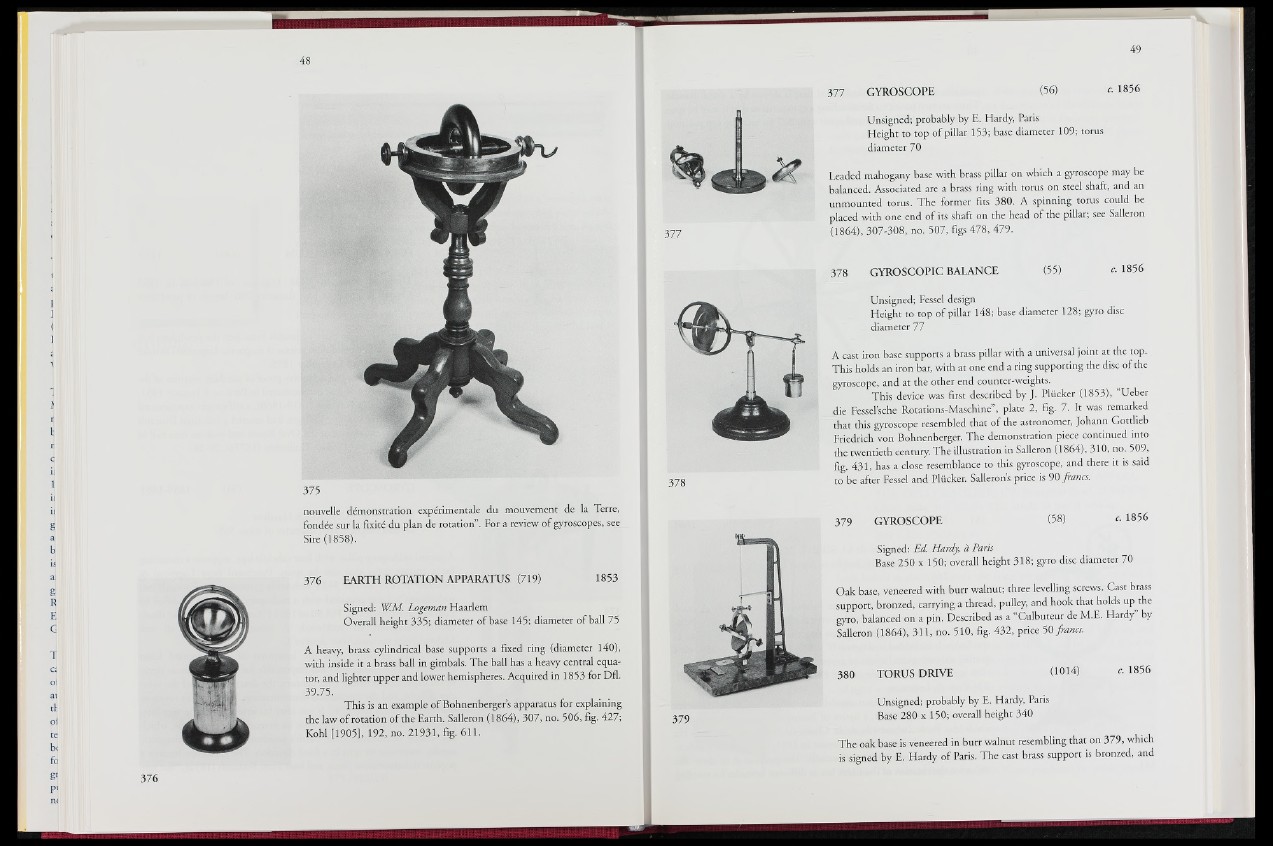
375
nouvelle démonstration expérimentale du mouvement de^MTerre,
fondée sur la fixité du plan de rotation”. For a review of gyroscopes, see
Sire' (1858).
376 EARTH ROTATION APPARATUS (71?) 1853
Signed: W.M. Logeman Haarlem
Overall height 335; diameter of base 145; diameter of ball 75
A heavy, brass cylindrical base supports a fixed ring (diameter 140),
with inside it a brass ball in gimbals. The ball has a heavy central equator,
and lighter upper and lower hemispheres. Acquired in 1853 for Dfl.
H I ^ Miiip r This is an example of Bohnenberger s apparatus for explaining
the law of rotation of the Earth. Salleron (1864), 307, no. 506, fig. 427;
Kohl [19051,392, no. 21931, fig. 611, ■'
377 GYROSCOPE - . a f i fN ) c- 1856
Unsigned; probably by E. Hardy, Paris
Height to top of pillar 153; base diameter 109; torus
diameter 70
Leaded mahogany base with brass pillar on which a gyroscope may be
balanced. Associated are a brass ring with torus on steel shaft, and an
unmounted torus. The former fits 380. A spinning torus could be
placed with one end of its shaft on the head of the pillar; see Salleron
(1864), ’307-308, no. 507, figs 478, 479,
378 GYROSCOPIC BALANCE (55) .‘- J r 1856
Unsigned; Fessel design
Height: to top of pillar 148; base diameter 128; gyro disc
diameter 7f
A cast iron base supports a brass pillar with a universal joint at the top.
This holds an iron bar, with at one end a ring supporting the disc of the
gyroscope, and at the other end counter-weights.
This device was first described by J. Pliicker (1853), Ueber
die Fessel’sche Rotations-Maschine”, plate 2, fig. 7. It was remarked
that thistgyroscope resembled that of the astronomer, Johann Gotdieb
Friedrich von Bohnenberger. The demonstration piece continued into
the twentieth century. The illustration in Salleron (1864), 310, no. 509,
fig. 431, has a close resemblance to this gyroscope, and there it is-^dd
to be after Fessel and Pliicker. ialleron’s price is 90 francs,
379 GYROSCOPE (58) c- 1856
Signed: Ed. Hardy, & Paris
Base 250 x 150; overall height 318; gyro disc diameter 70
Oak base, veneered with burr walnut; three levelling screws. Cast brass
support, bronzed, carrying a thread, pulley, and hook that holds up the
gyro, balanced on a pin. Described as a/j!8 |lbuteur de M.E. Hardy by
Salleron (1864), 311, no. 510, fig. 432, price %) francs.
380 TORUS DRIVE ¿ ( 1 0 1 * .. * 1856
Unsigned; probably by E. Hardy, Paris
Base 280 x 150; overall height 340
The oak base is veneered in burr walnut resembling that on 379, which
is signed by E. Hardy of Paris. The cast brass support is bronzed, and